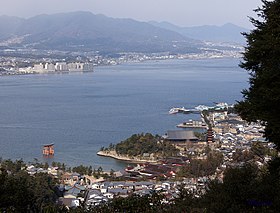Battle of Itsukushima
| Battle of Miyajima | |||||||
|---|---|---|---|---|---|---|---|
| Part of the Age of Warring States | |||||||
 View of Miyajima shore, with Itsukushima torii at left, and mainland in the distance (2012). |
|||||||
|
|||||||
| Belligerents | |||||||
|
|
|
||||||
| Commanders and leaders | |||||||
| Sue Harukata † |
Mōri Motonari Mōri Takamoto Kikkawa Motoharu Kobayakawa Takakage |
||||||
| Strength | |||||||
| 20,000-30,000 | 4,000-10,000 | ||||||
| Casualties and losses | |||||||
| ~4,700 | light | ||||||
The 1555 Battle of Miyajima (厳島合戦 Itsukushima Kassen?) was the only battle to be fought on the sacred island of Miyajima; the entire island is considered to be a Shinto shrine, and no birth or death is allowed on the island. Extensive purification rituals took place after the battle, to cleanse the shrine and the island of the pollution of death.
The Battle of Miyajima was the turning point in a campaign for control of the Ōuchi clan and of Aki Province, a strategically important province for establishing control of western Honshu. It was an important step for the Mōri clan in taking the foremost position in western Japan, and cemented the reputation of Mōri Motonari as a cunning strategist.
In 1551, Sue Harukata revolted against his lord Ōuchi Yoshitaka in the Tainei-ji incident, forcing him to commit seppuku. Sue installed the next lord of the clan, Ōuchi Yoshinaga, but effectively led the Ōuchi family and its armies, intent on military expansion. In 1554, Mōri Motonari, as a vassal of the Ōuchi clan, wanted to avenge the betrayed Yoshitaka, and so he rebelled against Sue, whose territorial ambitions were depleting clan resources. The heavily outnumbered force under Mōri attacked and defeated Sue at the Battle of Oshikibata. Mōri then departed from the mainland to build a fort, known as Miyao Castle, on Miyajima while proclaiming publicly his woe that it would not hold out long against an attack.
...
Wikipedia
